Mission: Impact podcast & blog
Build a better world without becoming a martyr to your nonprofit cause
Listen on:
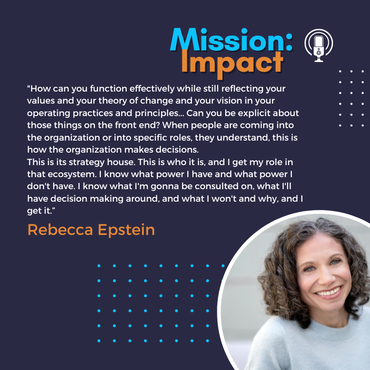 In episode 94 of Mission: Impact, Carol Hamilton and Rebecca Epstein discuss the article that Rebecca wrote with Mistinguette Smith published in the Nonprofit Quarterly in 2023. Paving a Better Way: What’s Driving Progressive Organizations Apart and How to Win by Coming Together. The conversation between Rebecca and Carol covers the intricacies and challenges of leadership and organizational dynamics within the nonprofit sector, particularly in the context of social justice work. Their discussion touches upon generational conflicts, power dynamics, organizational clarity, and strategies for effective leadership, especially in the recent crises we have all experienced over the past several years. Episode highlights: Generational and Cultural Dynamics in Nonprofits [00:08:30] The recent increased conflict within organizations between leaders and staff, often on generational and racial lines. How these conflicts are similar and different to those of the past. Addressing Internal Conflicts and Building Resilience [00:15:30] Conflicts within organizations, such as public call outs and accusations of racism as well as the push for structural changes. Organizational Clarity and Strategy - [00:20:30] The importance of organizational clarity regarding power and decision-making, and how it should reflect an organization's values and strategies. The Challenge of Aligning Strategy and Leadership - [00:25:30] The challenges organizations face in aligning their leadership style with their identity and mission as well as aligning expectations across segments of staff. Addressing Trauma in Nonprofits - [00:35:30] Understanding and addressing trauma embedded in social justice work – the trauma that stems from the issue the organization is addressing, intergenerational trauma, personal and interpersonal trauma. How might trauma at all these levels be addressed responsibly? Current Trends and Challenges The dialogue offers nonprofit leaders a range of insights and considerations for fostering healthy, effective, and resilient organizations that can navigate the complexities of social change work. Guest Bio:
Becca Epstein is a coach and consultant to social justice organizations and their leaders with over 20 years of experience in community organizing, organizational development, and nonprofit leadership. Becca is a co-founder of The Management Center, a former Vice President at Planned Parenthood Federation of America, and a convener of the “Paving a Better Way” working group. Her practice focuses on leaders, organizations, and movements confronting strategic challenges, seeking transformation, and advancing equity and justice. Becca holds an MPA in Nonprofit Management and Public Policy from NYU, a BA in Anthropology from Amherst College, and is a Certified Professional Coach. Important Links and Resources: Paving a Better Way: What’s Driving Progressive Organizations Apart and How to Win by Coming Together by Rebecca Epstein and Mistinguette Smith Building Resilient Organizations: Toward Joy and Durable Power in a Time of Crisis by Maurice Mitchell Learning From an Intergenerational Blowup Over Social Justice by Steve Kaagan & John Hagan Rebecca Epstein: https://www.linkedin.com/in/rebecca-epstein-797aa75/ https://www.beccaepsteincoaching.com/ Internal Family Systems - No Bad Parts: https://bookshop.org/p/books/no-bad-parts-healing-trauma-and-restoring-wholeness-with-the-internal-family-systems-model-richard-schwartz/16396062?gad_source=1&gclid=Cj0KCQjw-_mvBhDwARIsAA-Q0Q7ZNqD5nvZg5Rc0AW1G0doLAO72cWnAFeCHvmKdI5QkEjpu1QDdtWIaAtc-EALw_wcB Polarities - Polarity Partnerships: https://www.polaritypartnerships.com/ Related Episodes: These articles were also discussed on: Episode 75: Co-creation with Carol Hamilton and Danielle Marshall Nature of the employee-employer relationship/what is work: Episode 78: Renegotiating our relationship with work with Carol Hamilton Episode 85: Building equitable compensation frameworks with Mala Nagarajan "Click "Read More" for a transcript of the interview. 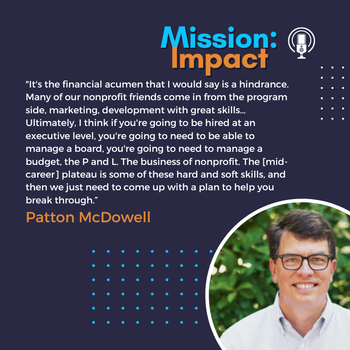 In episode 92 of Mission: Impact, Carol Hamilton and Patton McDowell explore the multi-generational nonprofit workforce, discussing the unique hurdles and opportunities that come with each stage of a non-profit career—from emerging leaders grappling with gaining practical experience to mid-career professionals encountering a plateau, and up to executive directors feeling isolated at the top. They underscore the importance of adaptability, continuous learning, and the benefits of strategic personal planning. Show highlights: Generational Workforce Challenges - [00:07:00] Discussion on the challenges faced by different generations in the nonprofit sector. Opportunity and Experience for Emerging Leaders - [00:08:05] Patton talks about the emerging leader generation facing the issue of opportunity and joy market entry difficulties Mid-Career Plateau - [00:19:25] Patton introduces the idea of a "mid-career plateau" and how to overcome it. Non-Traditional Career Paths - [00:22:00] Carol discusses lateral moves and specialization as alternatives to traditional progression. Executive Leadership Loneliness - [00:24:22] Patton discusses the isolation felt by those in executive leadership roles. Co-Executive Director Model - [00:29:00] Carol asks Patton about shared leadership roles and his views on them. Predictable Turnover - [00:33:00] Carol reflects on predictable turnover and proactive recruitment approaches. Organizational Exchanges - [00:39:10] Patton and Carol discuss the benefits of organizational exchanges and site visits. Personal Retreat for Leaders - [00:42:20] Patton recommends nonprofit leaders take personal retreats for strategic planning and Carol speaks on her own practice of personal strategic planning. Guest Bio:
Patton is the Founder of PMA Nonprofit Leadership, a coaching and consulting firm specializing in leadership development, fundraising, and strategic planning for nonprofits. He led fundraising efforts at two universities after starting his career at Special Olympics International. He's a Master Trainer for AFP Global, hosts the podcast Your Path to Nonprofit Leadership, and authored a best-selling book of the same name. He holds a bachelor's degree from UNC Chapel Hill, an MBA from Queens University of Charlotte, and a Doctorate from the University of Southern California. Patton currently serves as an Executive in Residence at the Jeb E. Brooks School of Public Policy at Cornell University. Important Links and Resources: Patton McDowell - https://www.linkedin.com/in/pattonmcdowell/ PMA Nonprofit https://www.pmanonprofit.com/ Charlie Gilkey - https://www.productiveflourishing.com/ Click "Read More" for a transcript of the interview. 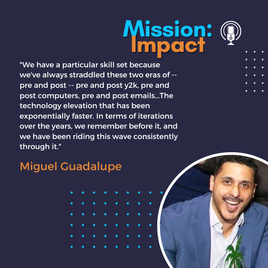 In episode 89 of Mission: Impact, Carol Hamilton and Miguel Guadalupe discuss issues of generational engagement in leadership, highlighting the frequent oversight of Generation X and stressing the unique adaptability and valuable perspective that this generation brings to the table. Miguel emphasizes the necessity for Generation X to advocate for recognition in leadership roles, reflecting on a LinkedIn post that sparked a broader conversation about the career stagnation felt by many in his generation. Episode highlights: Don’t Forget GenX: underrepresentation and unique contributions of Generation X in leadership and decision-making processes. Adapting to change: how Generation X's experience with the evolution of technology equips and other big changes over their career equips them with adaptability, a valuable skill set for leadership. Perpetual Utility player: Many of the Gen Xers who commented on Miguel’s LinkedIn post shared the feeling of being overlooked in their professional lives. Visibility and Advocacy: Miguel suggests that Generation X should take a lesson from Millenials and Gen Z and take a more assertive stance in advocating for their visibility and leadership opportunities. Guest Bio:
Miguel Guadalupe is Vice President of Donor and Community Relations at The Bowery Residents' Committee, or BRC in NYC. BRC helps over 10,000 individuals a year suffering from homelessness, mental illness, and addiction with the dignity and compassion they deserve. Miguel manages donor engagement, fundraising, and event planning, as well on service as BRC liaison to local elected officials, community organizations and businesses wherever a BRC program is located. He is also Vice Chair of the National Puerto Rican Day Parade, and helps to produce America's largest cultural celebration, in NYC, while helping to raise and distribute over $200K annually to students attending higher education. Important Links and Resources: Miguel’s viral LinkedIn post: https://www.linkedin.com/feed/update/urn:li:activity:7036817928465350656?updateEntityUrn=urn%3Ali%3Afs_feedUpdate%3A%28V2%2Curn%3Ali%3Aactivity%3A7036817928465350656%29 Miguel Guadalupe on LinkedIn: https://www.linkedin.com/in/miguelguadalupe/ The Bowery Residents' Committee https://www.brc.org/ Click "Read More" for Transcript 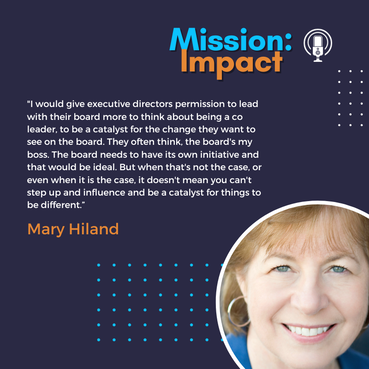 In this podcast episode, Carol Hamilton and Mary Hiland discuss the challenges and strategies of nonprofit executive directors working with their boards. They explore the importance of leaving a legacy and sharing knowledge, and how it inspired Carol to start her podcast, Mission Impact. Mary's book, "Love Your Board," is also discussed, focusing on the primary sources of trouble for executive directors when working with their boards. The conversation delves into the dimensions of capacity, connection, and culture within a board. They highlight the significance of building trust in board relationships and challenging assumptions in board recruitment. Additionally, they emphasize the need for emotional connection and individual check-ins with board members. (00:08:52) Dimensions of Board Challenges
(00:15:11) Building Trust in Board Relationships (00:21:39) Challenging Assumptions in Board Recruitment (00:27:55) Board Member Engagement Guest bio: Mary Hiland Ph.D. is a nonprofit governance expert and leadership development consultant dedicated to helping nonprofit leaders lead effectively. Mary has over forty years’ experience in the nonprofit sector – both as an executive and as a board member. She has been consulting and coaching nonprofit leaders for 20 years. Mary is a speaker, published author, researcher, and a business professor at her local community college. She is author of the #1 international best-seller: Love Your Board! The Executive Directors’ Guide to Discovering the Sources of Nonprofit Board Troubles and What to Do About Them (2021) And Mary is a contributing author to four other nonprofit leadership books. Mary is the founder and host of the podcast: Inspired Nonprofit Leadership Episode Links: Hiland Consulting: https://www.hilandconsulting.org/ Inspired Nonprofit Leadership: https://podcasts.apple.com/us/podcast/inspired-nonprofit-leadership/id1446218521 Talk with Mary: talkwithmary.com Alliance for Nonprofit Management: https://allianceonlinecommunity.org/ Click "Read More" for Transcript 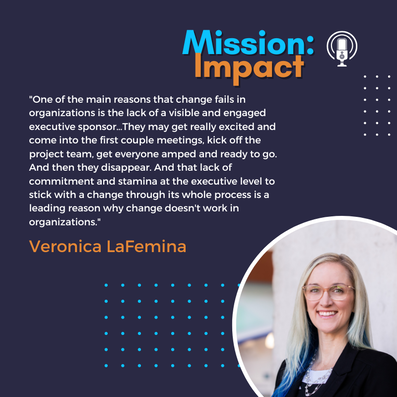 In episode 74 of Mission: Impact, Carol Hamilton and her guest, Veronica LaFemina discuss
Guest Bio: Veronica LaFemina is Founder and CEO of LaFemina & Co., an advisory firm supporting nonprofits and social impact businesses at the intersection of strategy, culture, communications, and change management. Veronica partners with organizations and their leaders to go beyond what “looks good on paper” to focus on what works well in real life. She is a leader, strategist, facilitator, trusted advisor, and certified change management professional with nearly two decades of experience as a senior executive at national U.S. nonprofit organizations and a high-impact consultant. Her work has been featured by Inc. Magazine, the Today Show, NPR, CNN, Capterra, and in news outlets nationwide. Important Links and Resources:
Click "Read More" for Transcript: |
Archives
April 2024

Grace Social Sector Consulting, LLC, owns the copyright in and to all content in and transcripts of the Mission: Impact podcast, as well as the Mission: Impact blog with all rights reserved, including right of publicity.
|
Telephone301-857-9335
|
info[at]gracesocialsector.com
|
Grace Social Sector Consulting, LLC, owns the copyright in and to all content in, including transcripts and audio of the Mission: Impact podcast and all content on this website, with all rights reserved, including right of publicity.
|